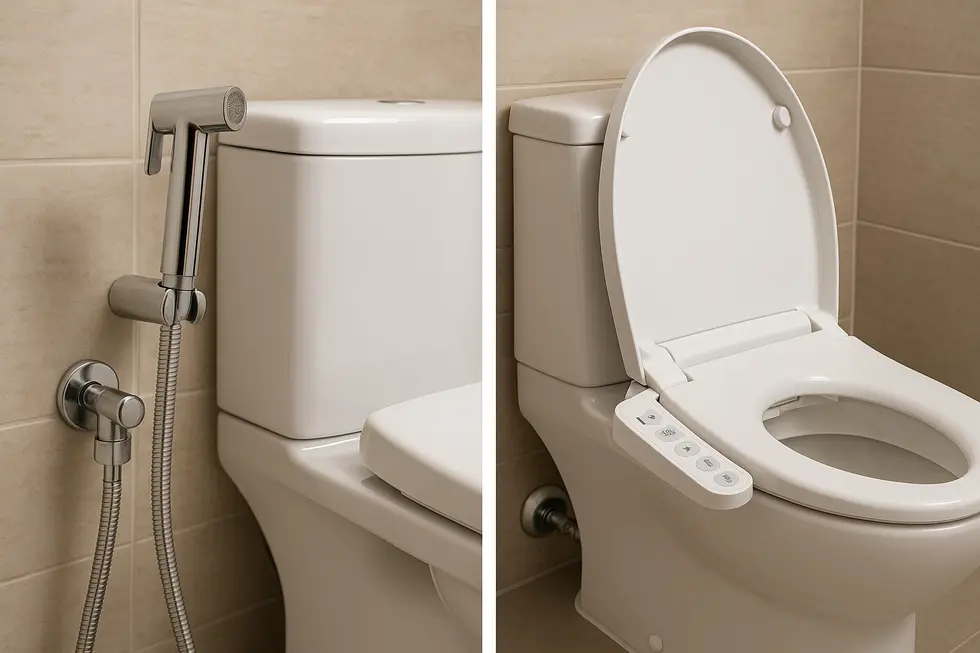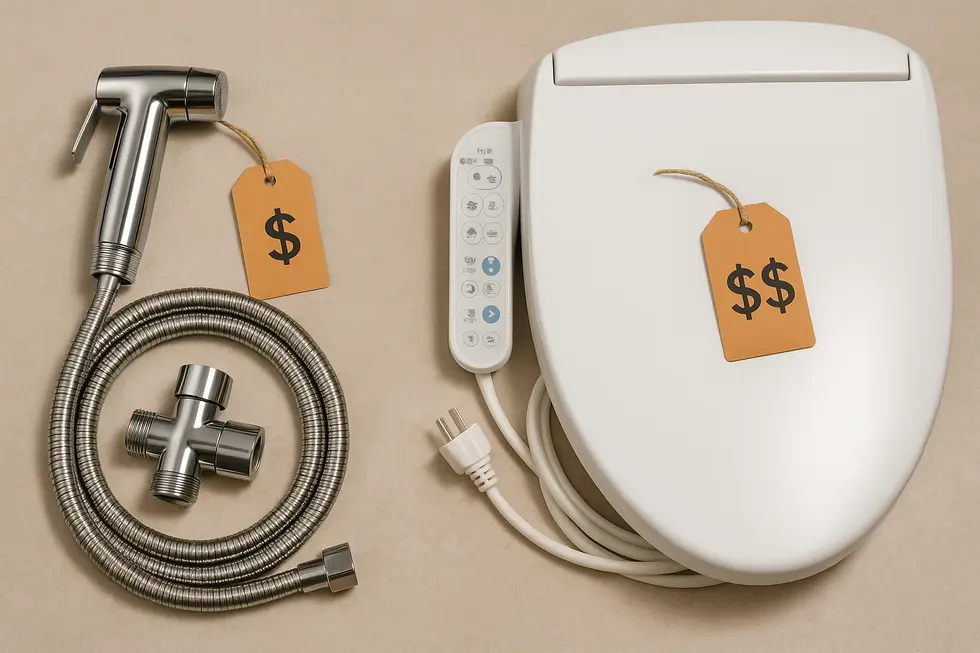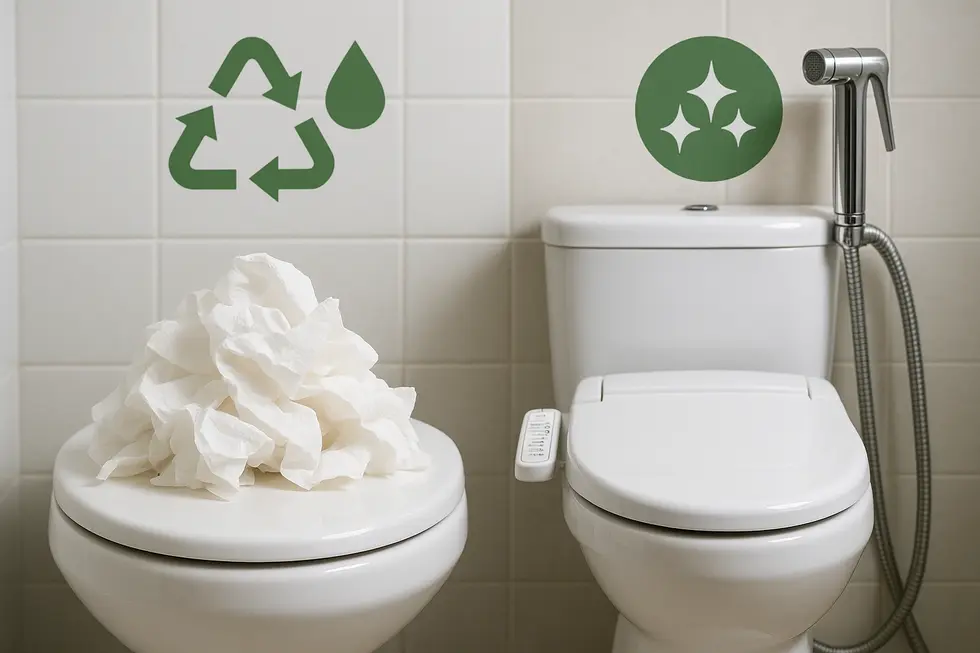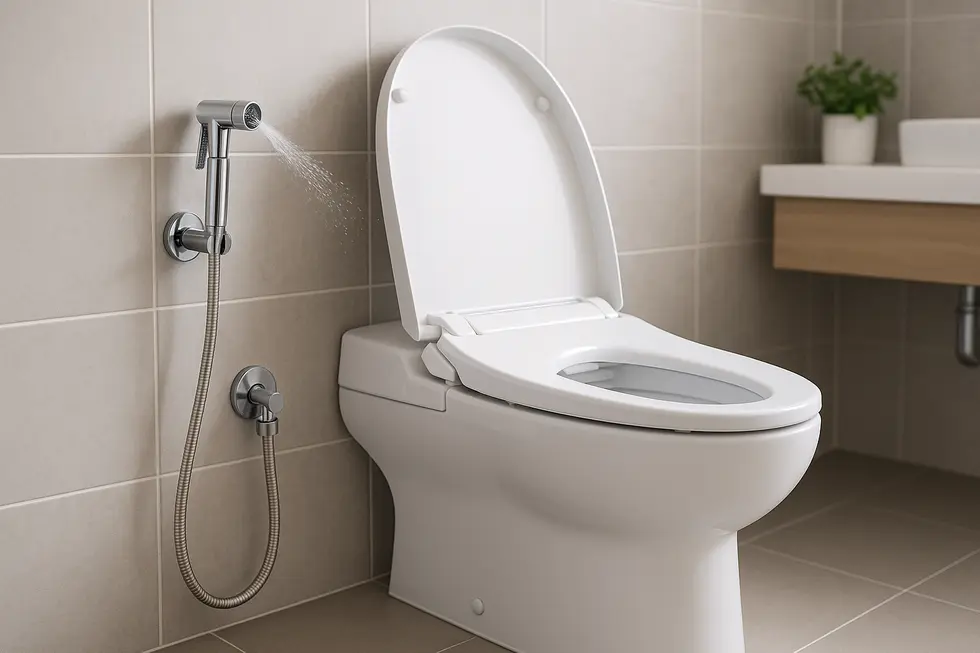Bidet Attachment, Bidet Seat
Bidet Sprayer vs Bidet: Making the Right Choice for Your Family’s Hygiene
As modern families become increasingly conscious of hygiene and environmental impacts, choosing between a bidet sprayer and a bidet seat is a significant decision. Each option offers distinct technological, economic, and environmental benefits. This guide will unpack those differences to help you make an informed choice. We’ll start by comparing the water delivery systems, then assess the cost implications, and finally evaluate their impact on hygiene and the environment.
From Pressure Jets to Smart Sprays: How Bidet Sprayers and Seats Deliver Water Differently

The heart of every bidet experience is water delivery, yet the way a handheld sprayer and an integrated bidet seat move water could not be more distinct. A bidet sprayer borrows the raw pressure already available in your home’s plumbing. By squeezing the trigger you release an unregulated column of water; flow strength is moderated only by the faucet valve and your grip. This direct, mechanical path keeps parts to a minimum, which explains the sprayer’s low price tag, almost universal compatibility, and impressive longevity. Because water exits the hose immediately, there is virtually no lag—ideal for users who want a brisk, targeted rinse or who need a multi-purpose tool that can wash cloth diapers, muddy shoes, or even the bowl itself.
A bidet seat replaces brute pressure with carefully choreographed hydraulics. Inside the housing, a small mixing chamber blends hot and cold supply lines (or heats cold water electrically) before pushing it through a motorized pump. Sensors track temperature and flow, while micro-controllers adjust nozzle angle, pulsation rhythm, or pre-mist functions. The result feels gentler, yet more enveloping, and can be personalized for each family member. Many models even store presets, so the seat remembers your preferred warmth and spray width the moment you sit down.
This sophistication carries trade-offs. Electric components demand an outlet, annual filter changes, and vigilance against mineral build-up. They also draw standby power, slightly enlarging the environmental footprint. In contrast, non-electric sprayers have no phantom energy use and typically require less than a half-liter per cleanse. If sustainability is paramount, exploring non-electric bidet attachments can be eye-opening; many families cut toilet-paper consumption by 70 % without ever plugging in a device.
Comfort preferences often tip the scale. People living in colder climates may prize warmed water, while those with limited mobility appreciate a seat that positions its own nozzle. Others value the full pressure of a sprayer for periodic deep cleaning.
Counting the Real Costs: Installation and Budget Impacts of Bidet Sprayers vs. Full Bidet Seats

For most households, the purchase price is the first hurdle when deciding between a handheld bidet sprayer and a full bidet seat. Sprayers usually cost a fraction of the price of even the simplest seat models because they contain no electronics, heating elements, or molded plastics. Their lean design lowers material costs and shipping weight, savings that appear directly on the price tag. In contrast, seats pack pumps, valves, and sometimes dryers, raising retail prices into triple digits.
Installation expenses deepen the gap. A sprayer usually threads onto the existing fill valve; a wrench and five minutes suffice. No seat removal, no electricity, and, crucially, no plumber call-out fee. A feature-rich seat often needs an electrical outlet within arm’s reach and a full seat swap. Homeowners comfortable with tools can manage, yet renters or busy families frequently hire help, adding labour costs that can rival the device itself. Guides that show how to add a bidet to an existing toilet illustrate how simple sprayer installs can be. Even when professional help is needed, a sprayer installation rarely exceeds the price of a restaurant meal, whereas seat installations can resemble the airfare for a weekend getaway.
Ongoing costs tell a similar story. Both gadgets slash toilet-paper use, which can save a household hundreds of rolls each year. The difference lies in utilities. A sprayer draws only cold water already present at the fixture, so its running cost is essentially zero. A heated seat consumes a small but continuous trickle of power to warm water and maintain seat temperature. Over a decade, those watts add up. Factor in filter replacements that some seats recommend, and the cost curve shifts further in favour of the humble sprayer.
Value, of course, is more than numbers. Many users are happy to pay extra for warm water, night lights, and automated cleansing that a premium seat provides. Others prioritise thrift or live in spaces where drilling holes for outlets is impossible. Understanding these trade-offs lets shoppers match the product to lifestyle rather than impulse. Seasoned reviewers note that entry-level attachments bridge the gap by offering bidet-like comfort without electrical complexity; see this independent installation guide for real-world examples.
Cleaner Bodies, Greener Planet: Weighing Hygiene and Environmental Gains of Bidet Sprayers vs. Full Bidets

Few bathroom upgrades influence both personal well-being and the planet as profoundly as trading toilet paper for a stream of water. Yet not all water-based solutions are equal. A handheld bidet sprayer and an integrated bidet seat share the same basic promise—less paper, better cleanliness—but the path each takes to deliver that promise differs in meaningful, measurable ways.
Every roll of tissue begins with felled trees, chemical pulping, bleaching, packaging, and trucking. Studies estimate the average person flushes away more than 15,000 sheets a year, a habit that quietly drives deforestation and releases considerable CO₂. A bidet seat can slash that paper use by up to 80 %, while a sprayer often eliminates it altogether because users can drip-dry or dab with a single square. The water needed? Only a fraction of the 37 gal required to manufacture one roll. Because sprayers draw directly from the existing cold-water line and rely on simple thumb-trigger mechanics, they avoid the standby electricity that keeps bidet seats’ reservoirs warm. That difference matters in regions where the grid leans on fossil fuels, further shrinking the sprayer’s carbon shadow.
Water efficiency does not come at the expense of hygiene. Both devices rinse away residue more thoroughly than dry wiping, reducing irritation, microtears, and lingering bacteria. The gentle pressure of a sprayer proves especially useful for postpartum care or limited mobility, letting users angle the nozzle precisely where needed without twisting. Bidet seats counter with adjustable temperatures and pulsating wash modes that pamper sensitive skin, but the heated streams can marginally increase energy bills.
Versatility tilts the scale again toward sprayers. They double as tools for rinsing cloth diapers, freshening the bowl, or even cleaning muddy shoes—small tasks that would otherwise require disposable wipes. Their modest price and five-minute installation lower the entry barrier for households curious about water cleansing. For renters or frequent travelers, a detachable sprayer offers an eco-friendly continuity that a permanent seat cannot match.
Ultimately, the choice rests on priorities: luxurious comfort with a moderate ecological footprint, or minimalist hardware that delivers near-zero paper waste and negligible energy draw. Either path marks a decisive step toward sustainable sanitation, amplified when paired with mindful drying habits and responsible water pressure settings. To see how compact devices multiply savings, explore the environmental benefits of portable bidets. Additional lifecycle data can be found in this industry FAQ on bidet sustainability.
Final thoughts
In conclusion, both bidet sprayers and bidet seats offer considerable benefits in terms of technology, cost, and environmental impact. Assessing your family’s needs in terms of budget, ease of installation, and desired hygiene levels will guide you in making the best selection for your home. Whether you prioritize eco-friendliness, advanced features, or affordability, both options present a significant upgrade over traditional methods.
Experience a new standard of clean with PEGABidet—designed for comfort, safety, and independence. Join thousands who trust us to make personal care simple and dignified. Contact us contact@pegabidet.com
About us
PEGABidet is a brand owned by L.A NEXTGEN LLC, based in California. We design intuitive, hygienic, and accessible bathroom solutions that prioritize safety, dignity, and independence. Our mission is to make personal care effortless and empowering for people at every stage of life.

